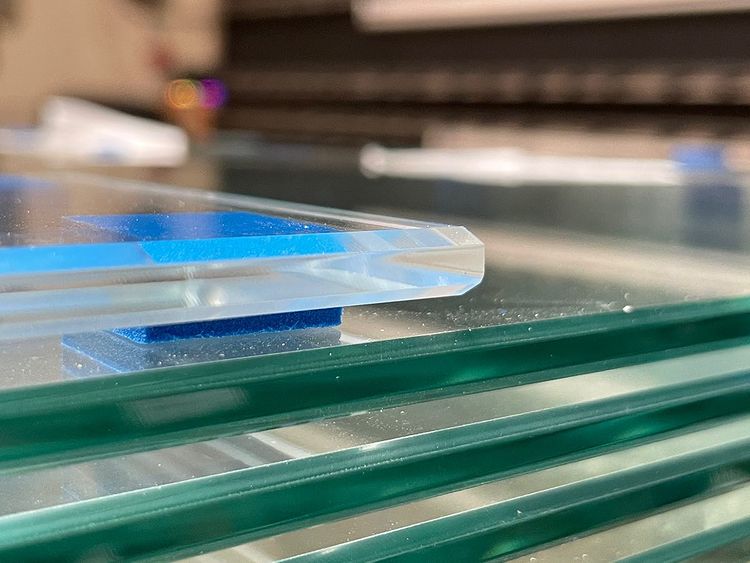Toughened Glass

Toughened glass is a type of safety glass that is manufactured through a process of extreme heating and rapid cooling. This makes it much harder than normal glass, and gives it superior strength and durability.
There are many benefits to using toughened glass, including its impact resistance and safety features. However, there are also some drawbacks to consider, such as the fact that it can be difficult to cut and shape.
If you are considering using toughened glass for your next project, it is important to weigh the pros and cons carefully to ensure that it is the right choice for you.
| Property | Toughened Glass | Laminated Glass | Regular Float Glass |
|---|---|---|---|
| Strength | High impact resistance; breaks into blunt pieces | Resists impact; holds together when shattered | Breaks easily; sharp shards |
| Safety Features | Safer upon breakage due to less sharp pieces | Excellent safety; holds broken pieces together | Low safety upon breakage |
| Manufacturing | Heated to high temperatures and then rapidly cooled | Two sheets of glass bonded with a layer of PVB | Cooled slowly after being formed |
| Applications | Building doors, windows, facades; vehicle windows | Windshields, skylights, sound barriers | Windows, picture frames, tabletops |
| Cost | More expensive due to complex manufacturing process | Most expensive due to materials and bonding process | Less expensive, standard glass |
| UV Resistance | Offers some UV resistance | Excellent UV resistance due to interlayer | Minimal UV resistance |
| Acoustic Insulation | Minimal | Good due to interlayer | Minimal |
Is Toughened Glass Unbreakable?
No, toughened glass is not unbreakable. However, it is much stronger than regular glass and is less likely to break under impact. If toughened glass does break, it will usually do so into small, safe pieces rather than large, sharp shards.
How is Toughened Glass Made?
To manufacture toughened or tempered glass, the process begins by cutting the glass to the desired size and shape using a specialized cutting machine. The glass is then carefully cleaned and inspected to ensure that it meets the required quality standards.
Next, the glass is placed into a tempering furnace, which is a specialized oven designed to heat the glass to its softening point. The glass is heated to a temperature of around 620-660°C, depending on the specific type of glass being used.
Once the glass has reached the proper temperature, it is rapidly cooled on both sides using blasts of cold air. This rapid cooling process, known as quenching, creates a tensile stress on the surface of the glass and a compressive stress in the core. The tensile stress on the surface makes the glass more resistant to breaking or shattering when subjected to impact, while the compressive stress in the core gives the glass increased strength and durability.
Applications for Toughened Glass
Toughened glass is commonly used in a variety of applications, including:
- Windows
- Doors
- Shower screens
- Tabletops
- Furniture
Advantages of Toughened Glass
- Increased strength and durability
- Impact resistance (5x stronger than regular glass)
- Safety features (shatters into pea-sized pebbles instead of sharp shards)
- Cheaper than laminated glass
Disadvantages of Toughened Glass
- More expensive than regular float glass
- Cannot be cut or modified after toughening process
Cost of Toughened Glass
The cost of toughened glass varies based on type, thickness, and size. Typically, it costs 2-3 times more than regular float glass but is cheaper than laminated glass. For example, 6mm toughened glass is approximately $130 per square meter, whereas regular float glass is about $45 per square meter and laminated glass costs around $230 per square meter.
Customer Case Studies
Case Study 1: Residential Renovation in Bondi Beach
Background:
One of our customers who lives in a waterfront property in Bondi Beach, Sydney, decided to undergo a comprehensive home renovation. Their primary concern was to maximize the ocean view while ensuring the safety and durability of their beachfront property.
Challenge:
Being a coastal area, Bondi Beach properties are exposed to salty sea breezes, which can cause corrosion. Moreover, the homeowner wanted large, uninterrupted glass panes, but ensuring safety was paramount due to the risk of high winds and potential accidents.
Solution:
Toughened glass was recommended. The large panes provided an unhindered view of the ocean, while the strength and resilience of the toughened glass ensured safety and longevity. The glass’s resistance to thermal stress also meant it could handle the heat of the harsh Australian sun without the risk of breaking.
Outcome:
The renovated property now boasts a stunning, panoramic view of the ocean. The homeowner enjoys peace of mind, knowing the glass is safe, durable, and requires minimal maintenance despite the challenging coastal conditions.
Case Study 2: Manly Library

Background:
The Northern Beaches Council decided to renovate the Manly library, aiming for a modern look that allowed ample natural light, creating an inviting space for readers.
Challenge:
Being a public space, the library would see high foot traffic, including children. The challenge was to introduce more natural light without compromising the safety of the public.
Solution:
Toughened glass walls and partitions were introduced. This allowed for more natural light to flood into reading areas, making them brighter and more inviting. Given that toughened glass is up to five times stronger than regular glass, it ensured the safety of the public even in high traffic areas.
Outcome:
Post-renovation, the Manly public library experienced a significant increase in visitors. Patrons appreciated the brighter, modern design, and the council was satisfied with the balance of aesthetics and safety that the toughened glass provided.
Toughened Glass FAQ
Toughened glass is an ideal choice for use in a variety of applications where strength and durability are important. Here are some situations where toughened glass may be a good choice:
When the glass will be subjected to significant stress or impact: Toughened glass is much stronger and more resistant to breakage than regular glass, making it a good choice for use in high-traffic areas or in situations where the glass may be subjected to significant stress. Examples include shower doors, windows, and doors in commercial buildings.
When the glass needs to be able to withstand extreme temperatures: Toughened glass is able to withstand extreme temperature fluctuations without breaking or shattering, making it a good choice for use in areas with extreme temperatures.
When the glass needs to be able to withstand wind pressure: Toughened glass is able to withstand significant wind pressure without breaking or shattering, making it a good choice for use in areas prone to strong winds.
When the glass needs to be able to withstand pressure or weight: Toughened glass is able to withstand significant pressure or weight without breaking or shattering, making it a good choice for use in applications where the glass may be subjected to heavy loads.
It is important to consider the specific requirements of a project when deciding whether to use toughened glass or another type of glass. Toughened glass has many benefits, but it may not always be the best choice for every application.
No, it’s not possible to drill or cut toughened glass as this would cause it to shatter. This rules out the option of installing pet doors into an existing toughened glass panel and the entire pane will need to be replaced.
There is no definitive answer as to which type of glass is better. It depends on the specific application and what your needs are. In general, toughened glass is stronger and more durable, while laminated glass is more resistant to shattering. For more info, you can read our article laminated glass vs toughened glass
You can identify whether glass is toughened by checking whether the edge of the glass is smooth. Toughened glass will always have a completely smooth edge due to the toughening process it goes through.
Also, you can look for a stamp or label that says “toughened” or “tempered” on the edges of the glass (usually in corner).
Toughened glass can be cleaned in the same way as regular glass. However, you should avoid using abrasive cleaners or scrubbing too hard, as this could damage the surface. Also, you should never use a razor blade on toughened glass as this will scratch the glass.

Khalil is the owner of Splendid Window Glass Repairs and has over 8 years experience as a glazier specialising in window glass repair, replacement and installations. Khalil takes great pride in his work and prides himself on providing an excellent service to all of his customers, no matter how big or small the job may be.
